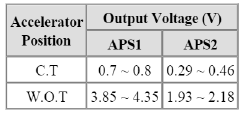Kia Sportage: Accelerator Position Sensor (APS) | Fuel Tank Pressure Sensor (FTPS)
Description and Operation
Description
Accelerator Position Sensor (APS) is installed on the accelerator pedal module and detects the rotation angle of the accelerator pedal. The APS is one of the most important sensors in engine control system, so it consists of the two sensors which adapt individual sensor power and ground line. The second sensor monitors the first sensor and its output voltage is half of the first one. If the ratio of the sensor 1 and 2 is out of the range (approximately 1/2), the diagnostic system judges that it is abnormal.

Specifications
Specification


Schematic Diagrams
Circuit Diagram

Repair procedures
Inspection
1. Connect the GDS on the Data Link Connector (DLC).
2. Turn the ignition switch ON.
3. Measure the output voltage of the APS 1 and 2 at C.T and W.O.T
Specification: Refer to "Specification"
Removal
Refer to "Accelerator Pedal" in this group.
Installation
Refer to "Accelerator Pedal" in this group.
Fuel Tank Pressure Sensor (FTPS)
Description and Operation
Description
Fuel Tank Pressure Sensor (FTPS) is a component of the evaporative emission control system. It is installed on the fuel tank near the fuel pump assembly. It checks the evaporative system and detects an evaporative leak in the system.

Specifications
Specification


Schematic Diagrams
Circuit Diagram

Repair procedures
Inspection
1. Connect the GDS on the Data Link Connector (DLC).
2. Measure the output voltage of the FTPS.
Specification: Refer to "Specification"
Removal
1. Turn the ignition switch OFF and disconnect the battery negative (-) cable.
2. Remove the rear seat (Refer to "Seat" in BD group).
3. Remove the fuel pump service cover (A).

4. Disconnect the fuel tank pressure sensor connector (A).
5. Remove the fuel tank pressure sensor after releasing the hooks vertically.

Installation
CAUTION
- Install the component with the specified torques.
- Note that internal damage may occur when the component is dropped. If the component has been dropped, inspect before installing.
CAUTION
- Insert the sensor in the installation hole and be careful not to damage.
1. Installation is reverse of removal.
READ NEXT:
 Injector
Injector
Description and Operation
Description
Based on information from various sensors, the ECM can calculate the fuel
amount to be injected. The fuel injector
is a solenoid-operated valve and the
 Purge Control Solenoid Valve (PCSV)
Purge Control Solenoid Valve (PCSV)
Description and
Operation
Description
Purge Control Solenoid Valve (PCSV) is installed on the surge tank and
controls the passage between the canister
and the intake manifold. It is a sole
SEE MORE:
 Starter Relay
Starter Relay
Repair procedures
Inspection
1. Remove the fuse box cover.
2. Remove the starter relay (A).
3. Using an ohmmeter, check that there is continuity between each terminal.
4. Apply 12V to terminal 85 and ground to terminal 86.
Check for continuity between terminals 30 and 87.
5. If ther
 Front Door
Front Door
Components and Components Location
Components
Front door trim
Front door inside handle cap
Front door trim seal
Front door quadrant inner cover
Front door module
Front door panel
Front door belt outside molding
Front door body side
weatherstrip
Front door side weathers
Content
- Home
- Kia Sportage - Fifth generation (NQ5) - (2022-2025) - Owner's Manual
- Kia Sportage - Second generation (JEKM) (2005-2015) - Body Workshop Manual
- Kia Sportage Third generation (SL) - (2011-2016) - Service and Repair Manual
- Sitemap
- Top articles